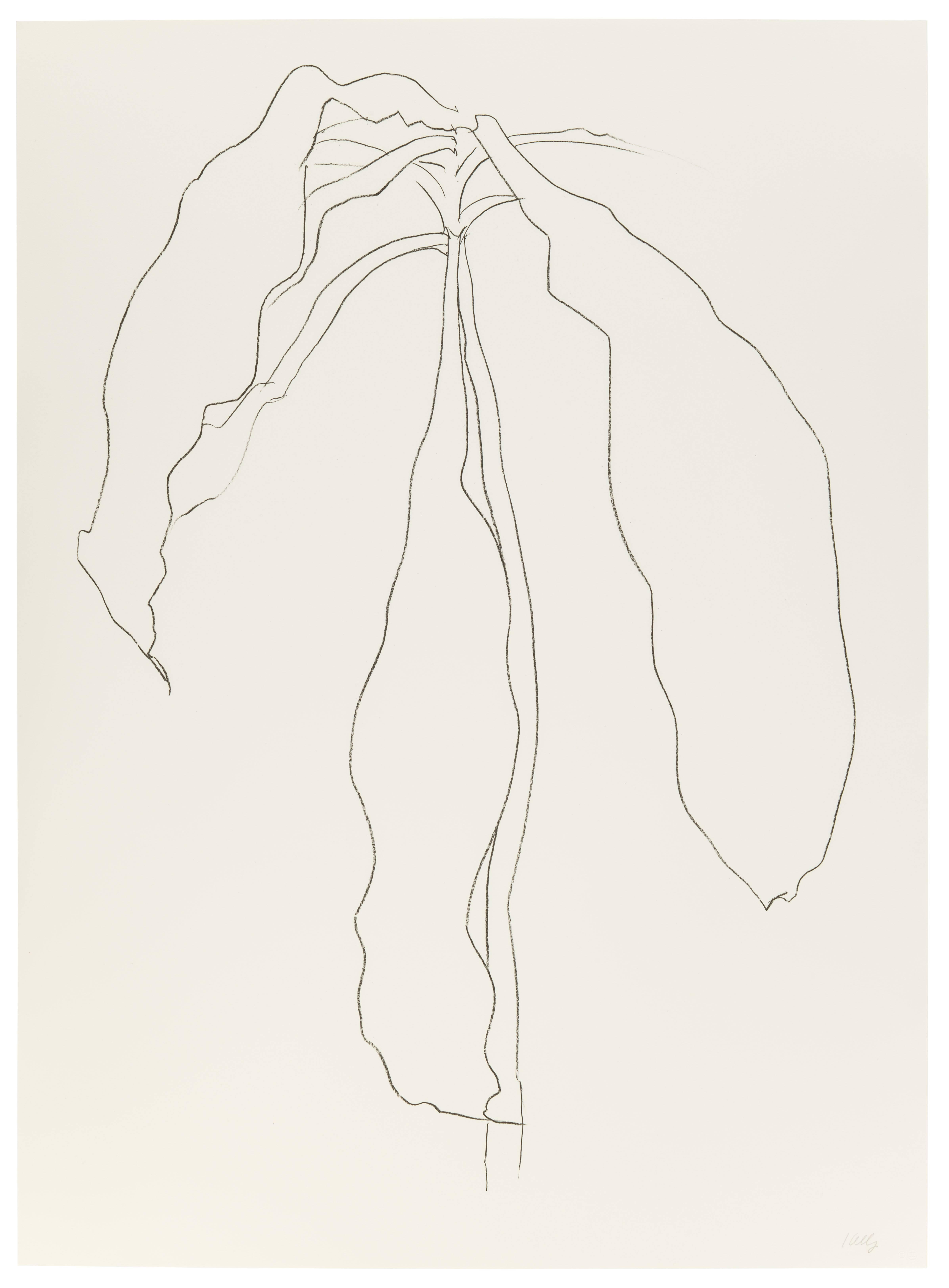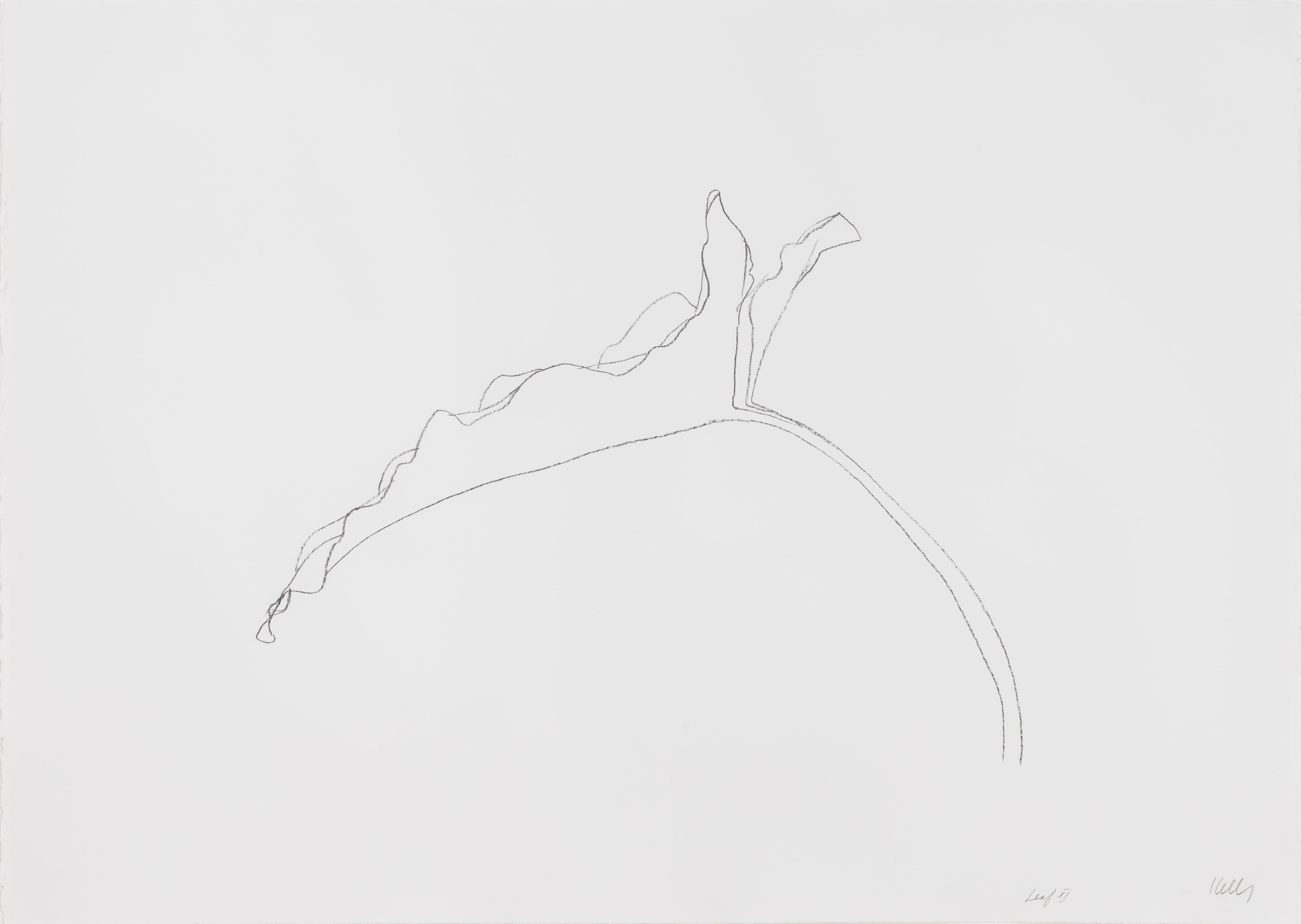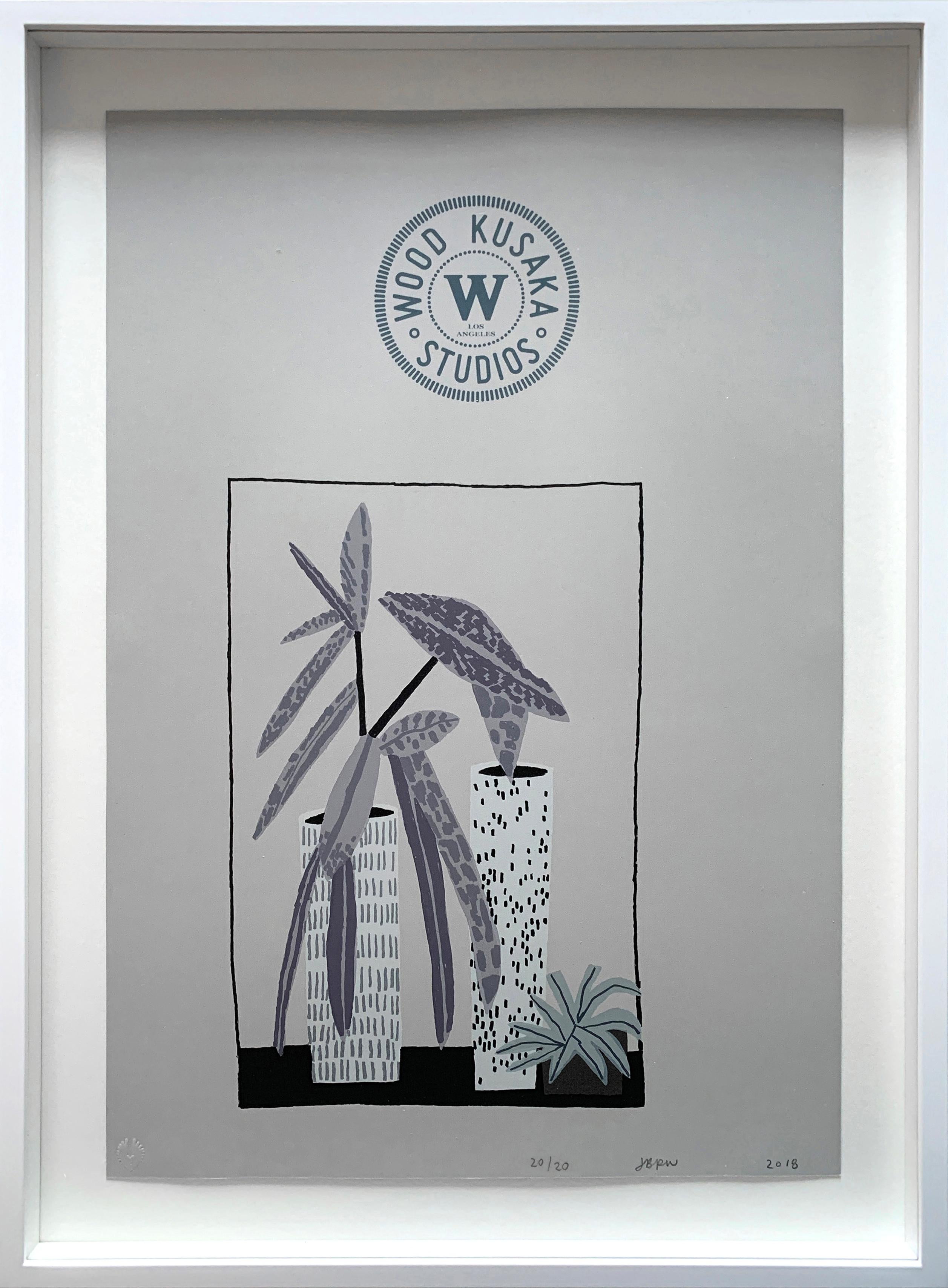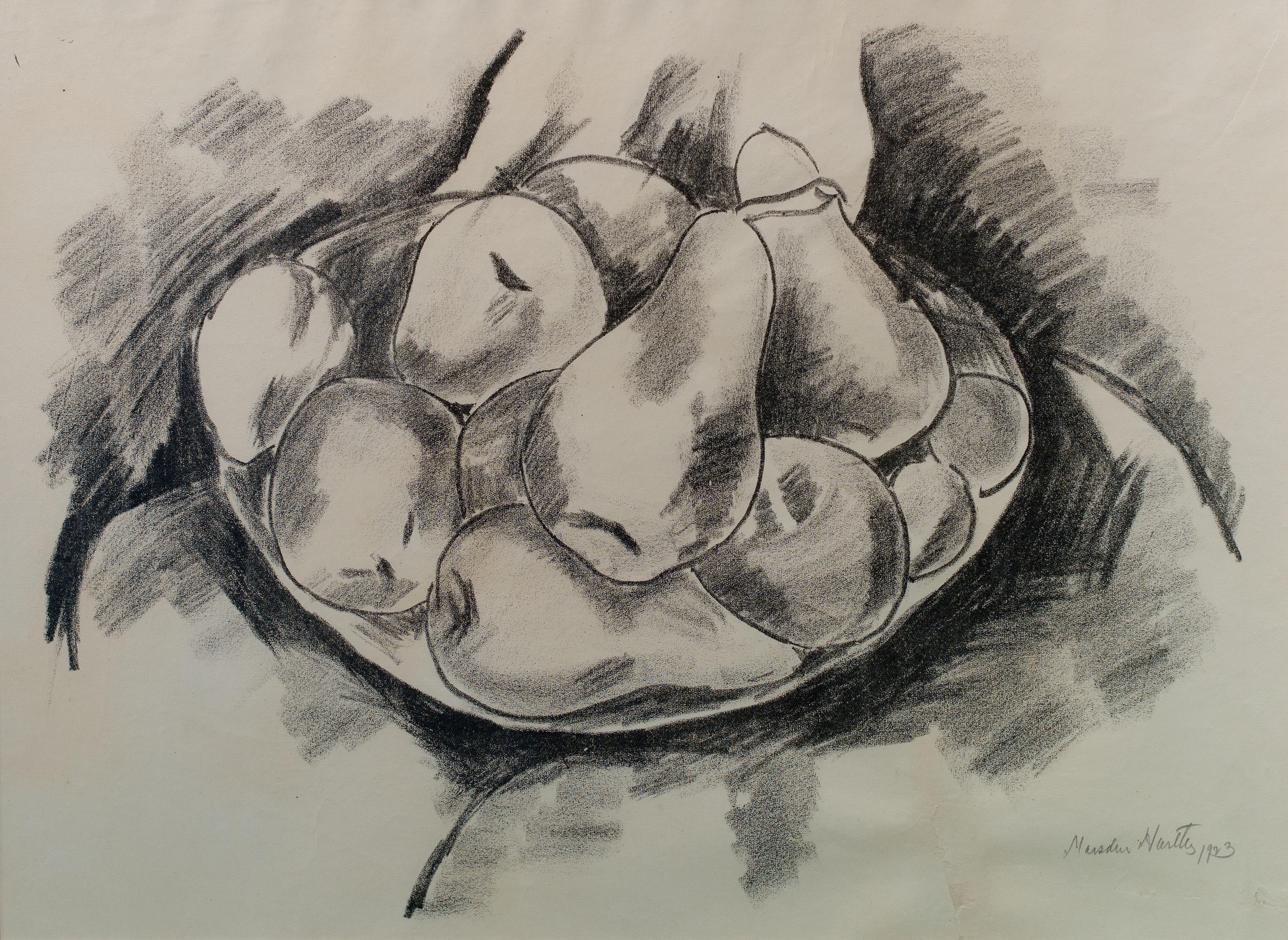Items Similar to "Campions, " Lithograph Still Life by Sheila Stafford
Want more images or videos?
Request additional images or videos from the seller
1 of 9
Sheila Stafford"Campions, " Lithograph Still Life by Sheila Stafford1985
1985
About the Item
"Campions" is an original color lithograph by Sheila Stafford. The artist signed the piece in the lower right and titled it and wrote the edition number (24/24) in the lower left - both in pencil. This piece depicts a glass with delicate flowers in front of an earthy green background.
9" x 11 1/2" art
18" x 20 1/2" frame
Sheila Stafford's training as an illustrator involved various forms of printmaking, including stone lithography and screen-printing. As an etcher, she is largely self-taught. She uses both copper and zinc plates which are printed on a Rochat press.
Sheila finds etching forms an ideal counterpoint to her earlier work as a book illustrator. She now concentrates mainly on etching, although painting forms an increasingly important aspect of her work.
Her sources of inspiration are mainly landscape and the immediate environment of her house and garden, peopled with an assortment of found and made objects - driftwood and pebbles from the beach, favorite pieces of pottery, cats, and plants. Landscapes are often conflated from several drawings, expressing the artist's response to the genius loci rather than being specific topographical portraits. In 1998 Sheila moved to West Wales, where she and her husband are restoring a Victorian Mill House. The location in a tranquil wooded valley is a new source of inspiration.
Sheila's work can be found in a number of galleries in the UK and at the David Barnett Gallery in Milwaukee. She has fulfilled commissions for such diverse clients as the BBC and London Contemporary Art.
- Creator:Sheila Stafford (British)
- Creation Year:1985
- Dimensions:Height: 18 in (45.72 cm)Width: 20.5 in (52.07 cm)
- Medium:
- Period:
- Condition:
- Gallery Location:Milwaukee, WI
- Reference Number:
About the Seller
4.9
Platinum Seller
These expertly vetted sellers are 1stDibs' most experienced sellers and are rated highest by our customers.
Established in 1966
1stDibs seller since 2017
392 sales on 1stDibs
Typical response time: 1 hour
- ShippingRetrieving quote...Ships From: Milwaukee, WI
- Return PolicyA return for this item may be initiated within 14 days of delivery.
More From This SellerView All
- "Bodegon - Still Life: Apple, Pear, & Funnel in Box, " Original Color LithographBy Armando MoralesLocated in Milwaukee, WI"Bodegon - Still Life: Apple, Pear & Funnel in Box" is an original color lithograph by Armando Morales. The artist signed the piece and this piece is the presentation proof for the e...Category
1980s Contemporary Still-life Prints
MaterialsLithograph
- 'The Prairie School Collection' exhibition poster Milwaukee Art MuseumBy (after) Frank Lloyd WrightLocated in Milwaukee, WIThis poster, produced for an exhibition at the Milwaukee Art Museum, features the bold work of American architect and designer Frank Lloyd Wright. Beneat...Category
1980s American Modern More Prints
MaterialsPaper, Lithograph, Offset
- "Two Bottles & Bowl, " Original Black & White Litho. signed by Joan Gardy ArtigasBy Joan Gardy ArtigasLocated in Milwaukee, WI"Two Bottles & Bowl" is an original lithograph by Joan Gardy Artigas. It depicts a still life in black and white. The artist signed the piece lower right and wrote the edition number...Category
Mid-20th Century Abstract Expressionist Still-life Prints
MaterialsLithograph
- "Counterpoise, " Original Color Lithograph signed by Jeanette Pasin-SloanBy Jeanette Pasin-SloanLocated in Milwaukee, WI"Counterpoise" is an original color lithograph by Jeanette Pasin-Sloan. It features a number of brightly colored hyper-realistic shining glassware. The artist signed the piece lower ...Category
Early 2000s Photorealist Still-life Prints
MaterialsLithograph
- "Fruit & Flowers, " Original Hand-colored Lithograph signed by Nathaniel CurrierBy Nathaniel CurrierLocated in Milwaukee, WI"Fruit & Flowers" is an original hand-colored lithograph by Nathaniel Currier. It features a still life with grapes, roses, and other botanical objects. The colors are muted blues and yellows. The artist signed the piece in plate lower left. 11 3/4" x 8 1/2" art 22 1/8" x 18" frame Nathaniel Currier was born March 27, 1813 to Nathaniel and Hannah Currier in Roxbury, Massachusetts. At the age of fifteen he was apprenticed to William S. and John Pendleton of Boston who had set up the first lithographic establishment in America. His apprenticeship served him well as he went on to be the largest publisher of lithographs. Mr. Maurer described Nat Currier as being very gentlemanly and liberal. As is evident to the success of the firm of Currier & Ives he was very devoted to his business. Nat Currier had many friends including Horace Greely and P.T. Barnum. He was well known for his sense of humor and Harry T. Peters tells one story about P. T. Barnum. "Currier had heard that one day his friend, the great showman, had rushed into the barber shop of the old Park Hotel, at Beekman and Nassau Streets, to get a shave. Barnum had hurried up to Tom Higginson, the barber, and said, 'Tom, I'm in a hurry.' 'Sorry for it,' said Tom, 'but it's that gentleman's turn next.' 'That gentleman' was an unshaven irshman waiting for a ten-cent shave. Barnum turned to him and said, 'My friend, if you will let me have your turn, I'll pay for what you have done.' The gentleman consented, and, as Barnum found out later, had a full job done - absolutely everything the house had. The check was for a dollar and sixty cents. When Currier heard this story he found the very Irishman and had him pose. The result was the famous cartoon, "The Man that Gave Barnum 'His Turn.'" Nathaniel was married twice; his first wife was Miss Eliza West of Boston. He had one son with Eliza, Edward West Currier. In 1847 he married Miss Laura Ormsbee of Vermont. Laura and Nathaniel are memorialized in the famous N. Currier lithograph The Road Winter...Category
1840s Academic Still-life Prints
MaterialsLithograph
- 'The Flower Vase' original hand-colored lithograph by Nathaniel CurrierBy Nathaniel CurrierLocated in Milwaukee, WIThe present hand-colored lithograph is one of several decorative images of flower-filled vases published by Nathaniel Currier. This example contains roses, tulips, forget-me-nots, and others all within a vase with gold eagle head handles and an image of a beautiful young woman the belly. 16 x 11 inches, artwork 22.5 x 18.25 inches, frame Entitled bottom center Signed in the stone, lower left "Lith. and Pub. by N. Currier" Inscribed lower right "152 Nassau St. Cor. of Spruce N.Y." Copyrighted bottom center "Entered according to Act of Congress in the year 1848 by N. Currier in the Clerk's office of the Southern District of N.Y." with the number 249 Framed to conservation standards using 100 percent rag matting, housed in a lemon gold moulding. Nathaniel Currier was a tall introspective man with a melancholy nature. He could captivate people with his piercing stare or charm them with his sparkling blue eyes. Nathaniel was born in Roxbury, Massachusetts on March 27th, 1813, the second of four children. His parents, Nathaniel and Hannah Currier, were distant cousins who lived a humble yet spartan life. When Nathaniel was eight years old, tragedy struck. Nathaniel’s father unexpectedly passed away leaving Nathaniel and his eleven-year-old brother Lorenzo to provide for the family. In addition to their mother, Nathaniel and Lorenzo had to care for six-year-old sister Elizabeth and two-year-old brother Charles. Nathaniel worked a series of odd jobs to support the family, and at fifteen, he started what would become a life-long career when he apprenticed in the Boston lithography shop of William and John Pendleton. A Bavarian gentleman named Alois Senefelder invented lithography just 30 years prior to young Nat Currier’s apprenticeship. While under the employ of the brothers Pendleton, Nat was taught the art of lithography by the firm’s chief printer, a French national named Dubois, who brought the lithography trade to America. Lithography involves grinding a piece of limestone flat and smooth then drawing in mirror image on the stone with a special grease pencil. After the image is completed, the stone is etched with a solution of aqua fortis leaving the greased areas in slight relief. Water is then used to wet the stone and greased-ink is rolled onto the raised areas. Since grease and water do not mix, the greased-ink is repelled by the moisture on the stone and clings to the original grease pencil lines. The stone is then placed in a press and used as a printing block to impart black on white images to paper. In 1833, now twenty-years old and an accomplished lithographer, Nat Currier left Boston and moved to Philadelphia to do contract work for M.E.D. Brown, a noted engraver and printer. With the promise of good money, Currier hired on to help Brown prepare lithographic stones of scientific images for the American Journal of Sciences and Arts. When Nat completed the contract work in 1834, he traveled to New York City to work once again for his mentor John Pendleton, who was now operating his own shop located at 137 Broadway. Soon after the reunion, Pendleton expressed an interest in returning to Boston and offered to sell his print shop to Currier. Young Nat did not have the financial resources to buy the shop, but being the resourceful type he found another local printer by the name of Stodart. Together they bought Pendleton’s business. The firm ‘Currier & Stodart’ specialized in "job" printing. They produced many different types of printed items, most notably music manuscripts for local publishers. By 1835, Stodart was frustrated that the business was not making enough money and he ended the partnership, taking his investment with him. With little more than some lithographic stones, and a talent for his trade, twenty-two year old Nat Currier set up shop in a temporary office at 1 Wall Street in New York City. He named his new enterprise ‘N. Currier, Lithographer’ Nathaniel continued as a job printer and duplicated everything from music sheets to architectural plans. He experimented with portraits, disaster scenes and memorial prints, and any thing that he could sell to the public from tables in front of his shop. During 1835 he produced a disaster print Ruins of the Planter's Hotel, New Orleans, which fell at two O’clock on the Morning of the 15th of May 1835, burying 50 persons, 40 of whom Escaped with their Lives. The public had a thirst for newsworthy events, and newspapers of the day did not include pictures. By producing this print, Nat gave the public a new way to “see” the news. The print sold reasonably well, an important fact that was not lost on Currier. Nat met and married Eliza Farnsworth in 1840. He also produced a print that same year titled Awful Conflagration of the Steamboat Lexington in Long Island Sound on Monday Evening, January 18, 1840, by which melancholy occurrence over One Hundred Persons Perished. This print sold out very quickly, and Currier was approached by an enterprising publication who contracted him to print a single sheet addition of their paper, the New York Sun. This single page paper is presumed to be the first illustrated newspaper ever published. The success of the Lexington print launched his career nationally and put him in a position to finally lift his family up. In 1841, Nat and Eliza had their first child, a son they named Edward West Currier. That same year Nat hired his twenty-one year old brother Charles and taught him the lithography trade, he also hired his artistically inclined brother Lorenzo to travel out west and make sketches of the new frontier as material for future prints. Charles worked for the firm on and off over the years, and invented a new type of lithographic crayon which he patented and named the Crayola. Lorenzo continued selling sketches to Nat for the next few years. In 1843, Nat and Eliza had a daughter, Eliza West Currier, but tragedy struck in early 1847 when their young daughter died from a prolonged illness. Nat and Eliza were grief stricken, and Eliza, driven by despair, gave up on life and passed away just four months after her daughter’s death. The subject of Nat Currier’s artwork changed following the death of his wife and daughter, and he produced many memorial prints and sentimental prints during the late 1840s. The memorial prints generally depicted grief stricken families posed by gravestones (the stones were left blank so the purchasers could fill in the names of the dearly departed). The sentimental prints usually depicted idealized portraits of women and children, titled with popular Christian names of the day. Late in 1847, Nat Currier married Lura Ormsbee, a friend of the family. Lura was a self-sufficient woman, and she immediately set out to help Nat raise six-year-old Edward and get their house in order. In 1849, Lura delivered a son, Walter Black Currier, but fate dealt them a blow when young Walter died one year later. While Nat and Lura were grieving the loss of their new son, word came from San Francisco that Nat’s brother Lorenzo had also passed away from a brief illness. Nat sank deeper into his natural quiet melancholy. Friends stopped by to console the couple, and Lura began to set an extra place at their table for these unexpected guests. She continued this tradition throughout their lives. In 1852, Charles introduced a friend, James Merritt Ives, to Nat and suggested he hire him as a bookkeeper. Jim Ives was a native New Yorker born in 1824 and raised on the grounds of Bellevue Hospital where his father was employed as superintendent. Jim was a self-trained artist and professional bookkeeper. He was also a plump and jovial man, presenting the exact opposite image of his new boss. Jim Ives met Charles Currier through Caroline Clark, the object of Jim’s affection. Caroline’s sister Elizabeth was married to Charles, and Caroline was a close friend of the Currier family. Jim eventually proposed marriage to Caroline and solicited an introduction to Nat Currier, through Charles, in hopes of securing a more stable income to support his future wife. Ives quickly set out to improve and modernize his new employer’s bookkeeping methods. He reorganized the firm’s sizable inventory, and used his artistic skills to streamline the firm’s production methods. By 1857, Nathaniel had become so dependent on Jims’ skills and initiative that he offered him a full partnership in the firm and appointed him general manager. The two men chose the name ‘Currier & Ives’ for the new partnership, and became close friends. Currier & Ives produced their prints in a building at 33 Spruce Street where they occupied the third, fourth and fifth floors. The third floor was devoted to the hand operated printing presses that were built by Nat's cousin, Cyrus Currier, at his shop Cyrus Currier & Sons in Newark, NJ. The fourth floor found the artists, lithographers and the stone grinders at work. The fifth floor housed the coloring department, and was one of the earliest production lines in the country. The colorists were generally immigrant girls, mostly German, who came to America with some formal artistic training. Each colorist was responsible for adding a single color to a print. As a colorist finished applying their color, the print was passed down the line to the next colorist to add their color. The colorists worked from a master print displayed above their table, which showed where the proper colors were to be placed. At the end of the table was a touch up artist who checked the prints for quality, touching-in areas that may have been missed as it passed down the line. During the Civil War, demand for prints became so great that coloring stencils were developed to speed up production. Although most Currier & Ives prints were colored in house, some were sent out to contract artists. The rate Currier & Ives paid these artists for coloring work was one dollar per one hundred small folios (a penny a print) and one dollar per one dozen large folios. Currier & Ives also offered uncolored prints to dealers, with instructions (included on the price list) on how to 'prepare the prints for coloring.' In addition, schools could order uncolored prints from the firm’s catalogue to use in their painting classes. Nathaniel Currier and James Merritt Ives attracted a wide circle of friends during their years in business. Some of their more famous acquaintances included Horace Greeley, Phineas T. Barnum, and the outspoken abolitionists Rev. Henry Ward, and John Greenleaf Whittier (the latter being a cousin of Mr. Currier). Nat Currier and Jim Ives described their business as "Publishers of Cheap and Popular Pictures" and produced many categories of prints. These included Disaster Scenes, Sentimental Images, Sports, Humor, Hunting Scenes, Politics, Religion, City and Rural Scenes, Trains, Ships, Fire Fighters, Famous Race Horses, Historical Portraits, and just about any other topic that satisfied the general public's taste. In all, the firm produced in excess of 7500 different titles, totaling over one million prints produced from 1835 to 1907. Nat Currier retired in 1880, and signed over his share of the firm to his son Edward. Nat died eight years later at his summer home 'Lion’s Gate' in Amesbury, Massachusetts. Jim Ives remained active in the firm until his death in 1895, when his share of the firm passed to his eldest son, Chauncey. In 1902, faced will failing health from the ravages of Tuberculosis, Edward Currier sold his share of the firm to Chauncey Ives...Category
1840s Romantic Still-life Prints
MaterialsWatercolor, Lithograph
You May Also Like
- In the CloudBy Yoshitomo NaraLocated in Bristol, GBLithograph in colours, on Arches paper, with full margins Edition of 150 42.2 x 33 cm (16.6 x 12.9 in) Signed, numbered and dated on the front Mint. Artwork not inspected outside of ...Category
21st Century and Contemporary Contemporary Still-life Prints
MaterialsLithograph
- Dracena IIBy Ellsworth KellyLocated in New York, NYPrinter: Gemini, G.E.L., Los Angeles Publisher: Gemini, G.E.L., Los Angeles Catalogue raisonné: Axsom 213 Edition size: 30, plus proofs Signed and numbered in pencil, lower rightCategory
1980s Minimalist Still-life Prints
MaterialsLithograph
- Leaf IVBy Ellsworth KellyLocated in New York, NYPortfolio: Twelve Leaves Printer and Publisher: Gemini, G.E.L., Los Angeles Edition size: 20, plus proofs Signed, titled, and numbered in pencil, lower right Catalogue Raisonné: Axso...Category
1970s Contemporary Still-life Prints
MaterialsLithograph
- Leaf XIBy Ellsworth KellyLocated in New York, NYPrinter and Publisher: Gemini G.E.L., Los Angeles Edition size: 20, plus proofs Catalogue Raisonné: Axsom 176 Signed, titled, and numbered in pencil, lower marginCategory
1970s Still-life Prints
MaterialsLithograph
- Notepad Doodle 3, State IIIBy Jonas WoodLocated in London, GBLithograph in colours, on grey Magnani Pescia paper. Published in 2018. Limited edition 20/20. Co-published in 2018 by WKS Editions and Hamilton Press, Los Angeles. Hand signed and n...Category
2010s Contemporary Still-life Prints
MaterialsLithograph
- Dish of Apples and PearsBy Marsden HartleyLocated in Provincetown, MAMarsden Hartley is a seminal figure in American arts even eighty-plus years after his death. Hartley was a member of Alfred Stieglitz’s groundbreaking circle and painted easel-sized ...Category
Early 20th Century American Impressionist Still-life Prints
MaterialsLithograph
Recently Viewed
View AllMore Ways To Browse
Vintage Copper Still
Glass Cat Signed
Used Mill Stones
Glass Cat Green
Pottery Cat
Vintage Garden Uk
Victorian Vintage Portrait
Victorian Vintage Portraits
Driftwood Framed
Wales Etchings
Vintage Driftwood Art
Vintage Cat Pottery
Stafford Vintage
Retro Cat Pottery
Vintage Victorian Flower Paintings
Victorian Vintage Cats
Victorian Vintage Cat
Dali Pear




